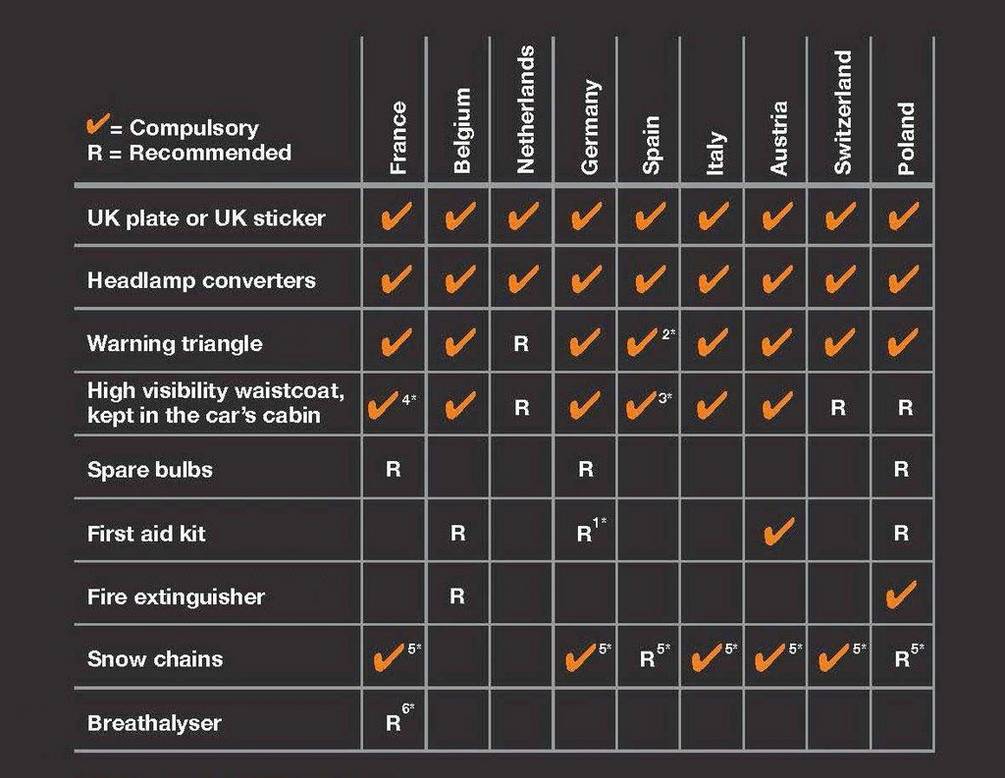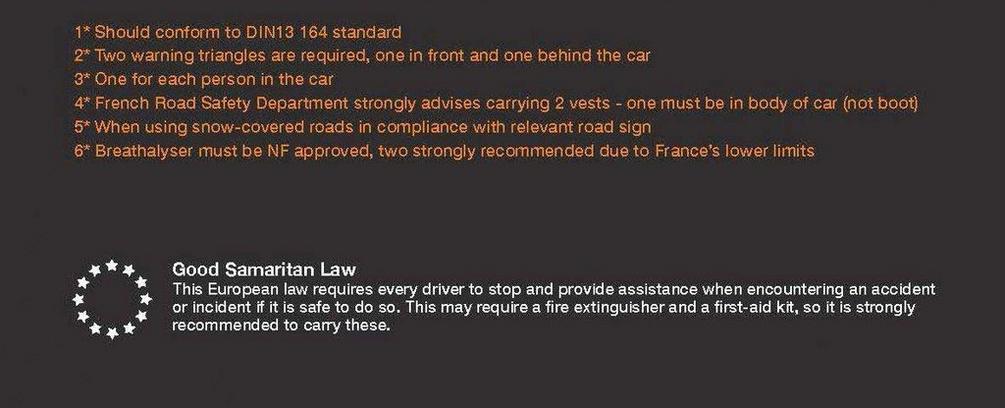Driving in Europe
If you're heading abroad with your car, you may be wondering what the legal requirements are for driving in Europe – and particularly, driving in Europe after Brexit.
To make it easier, we've put together a driving in Europe checklist, covering areas such as driving licenses, car insurance, and UK stickers. Not having the correct documentation could land you a heavy fine, so have a read to make sure that you’ve got everything you need before you set off.
Read our driving abroad checklist
Driving in Europe documents
UK driving license
You need to take your UK driving license with you when you drive in Europe. Check that it’s still valid and renew it online if it’s expired (or about to expire) at least two weeks before you travel.
International driving permit (IDP)
You don’t need an IDP to drive in the EU, Iceland, Liechtenstein, Norway or Switzerland as long as you have a UK photocard driving license.
However, you might need an IDP to drive in some EU countries and Norway if you have:
- a paper driving license
- a license issued in Gibraltar, Guernsey, Jersey or the Isle of Man.
In certain countries, a UK driving license alone is not adequate so an IDP will be required. Some of these countries include:
- USA
- Turkey
- Brazil
- Japan
You should check with the embassy of the country you’ll be driving in to find out more. You may also need an IDP if you’re planning to visit a European country that’s not mentioned in the list above.
IDPs can be bought at Post Offices for £5.50. There are three different types, which are known as the 1926, 1949 and 1968 IDPs (the numbers refer to the dates of the conventions on road traffic that established them). The particular IDP you may need depends on what country you’re visiting. You can find a full breakdown of the IDP types by country here.
Certificate of motor insurance
You’ll need a certificate of motor insurance when driving in Europe. However, from 21st August 2021, a green card (also known as an International Motor Insurance Card) is no longer required when driving in EU countries. A Green Card proves that your UK motor insurance policy provides you with the minimum compulsory insurance cover required by the law of the country you're visiting. A green card may be required for other countries – a few examples include:
- Morocco
- Turkey
- Tunisia
In other countries, you may need additional insurance as well as a green card to show that you’re covered. Check the travel advice for the country you’re driving in to find out more.
Contact your insurer to find out how to get a green card for driving in Europe. They’ll either post a green card to you (allow up to six weeks for this) or tell you how to download and print a green card yourself.
Vehicle registration documents
If you’re taking your own vehicle to Europe for less than 12 months, then you'll need to carry your V5C log book with you.
If you’re taking a car that you’ve hired or leased, then you’ll need to get a VE103 form to show you have permission to take it out of the UK.
UK stickers
To travel in the EU, you either need a number plate with a UK flag on it or a UK sticker that’s clearly displayed on the rear of your car*. Contact your local Halfords store to find out how to order a UK number plate or buy a UK sticker online.
Please note: On September 28th 2021, 'UK' stickers replaced 'GB' stickers. If your vehicle still has a 'GB' sticker, you’ll need to change it to a 'UK' sticker before travelling in Europe.
European breakdown cover
Check that your existing car insurance covers you if you breakdown abroad. If not, you’ll either need to amend your existing policy or take out separate European breakdown cover. Repair costs in Europe can be pricey, so essential to ensure you’re adequately covered.
Driving and safety essentials to have in your car
Different European countries have different laws regarding what products you need to carry in your car. Here are the products that we’d always recommend having to hand when you’re driving in Europe, whether they’re specifically required by law or not.
High visibility jackets
It is a legal requirement to carry a high visibility jacket with you in a number of European countries, so that you can be seen by other drivers if you breakdown. . If you're travelling with other people, get one for each of your companions and ensure they're kept in the passenger compartment, not the boot.
Warning triangles
Warning triangles can be placed on the road to alert other drivers if you have a breakdown or emergency. They're a legal requirement in most EU nations, although the number required differs from country to country.
Breathalyser
While you’re no longer legally required to carry a breathalyser kit in France, it is still strongly advised.
We recommend carrying a disposable breathalyser in the car since legal alcohol limits are much stricter across Europe compared to in the UK; France’s blood alcohol limit is 0.05%, while the UK’s is 0.08%. You’ll find the same lower limit in Belgium, Germany, Netherlands, Italy, Spain, Austria, Denmark, Finland, Luxembourg, Switzerland, and Turkey too.
To be approved for use in France, the breathalyser needs to meet the NF French National Standard. You’ll also need to make sure that your breathalyser is in date, as disposable tests will have an expiry date.
Headlamp converters and spare bulb kits
To ensure you don't dazzle oncoming traffic, you'll need headlamp converters. This is because headlights on British cars are designed for driving on the left, not the right. Headlamp converters reposition the angle of the beam, ensuring other drivers are safe as well as improving your visibility.
Most European nations also recommend carrying a spare bulb kit so you can change your headlamps if one of them goes.
First aid kit
It’s always a good idea to have a first aid kit in your car, just in case someone gets hurt. Carrying a first aid kit is also a legal requirement in many European countries.
TOP TIP: For greater convenience, consider carrying a European driving kit. The Halfords Motoring Abroad Kit contains all of the products discussed above, so it’s a handy and cost-effective way to pick up all the essentials you need for driving abroad.
Driving Abroad Checklist
Use our checklist to check which items are compulsory or recommended for when you drive abroad.


Tyre laws by country
As with any long journey, it’s essential to check your tyres before setting off. Regardless of which country you are driving in, always make sure your tyres are correctly inflated. If you’re not sure what your tyre pressure should be, check your vehicle handbook. Here are the key tyre laws for some of the most popular European countries:
FranceIf you’re driving in France, there’s no need to carry a spare wheel in the vehicle or fit cars with winter tyres. However, when doing your tyre checks, make sure that each tyre has a minimum tread depth of 1.6mm.
BelgiumSimilarly to France, Belgian law states that tyres should have a minimum tread depth of 1.6mm. Winter tyres are also not mandatory.
NetherlandsWinter tyres are not mandatory in the Netherlands during the colder months and all-season tyres are sufficient. The minimum tread depth in the Netherlands is also 1.6mm.
GermanyWhile 1.6mm is the minimum tread depth in Germany, it is highly recommended that this doesn’t go below 4mm. However, if you’re driving in wintery conditions such as ice, snow and slush, it’s mandatory to have winter tyres that feature the Alpine symbol.
SpainSpanish law requires you to carry a spare tyre or puncture repair kit in the vehicle. It’s essential that all tyres are correctly inflated and have 1.6mm tread depth.
ItalyDuring the winter months (15th November to 15th April) winter tyres are mandatory when driving around certain areas in Italy, particularly mountainous regions. The minimum tread depth is 1.6mm.
AustriaAustria also requires winter tyres to be fitted between 15th November – 15th April and must have a minimum tread depth of 4mm. You can be fined if your vehicle is not fitted with the appropriate tyres. Outside of the winter period, when summer or all-season tyres can be used, the minimum tread depth is 1.6mm.
SwitzerlandThere is no obligation for winter tyres when driving in Switzerland. While the minimum tread depth is 1.6mm it’s recommended that this does not go below 4mm during winter and 3mm during summer.
PolandMinimum tread depth in Poland is 1.6mm and there is no obligation to fit winter tyres during the colder months.
Further tips for driving in Europe
To conclude, here's some more general advice for driving in Europe:
- Check your car insurance and breakdown cover to ensure you're covered abroad.
- Check which documents you're required to carry, following our guidance above.
- Familiarise yourself with local speed limits, road signs and driving styles.
- Drive cautiously and remember to drive on the right side of the road.
- Ensure you're up to date on the latest driving laws for whichever country you're visiting. Laws can change quickly and we don't want you to be caught out!
Back to Expert Advice
05/23
